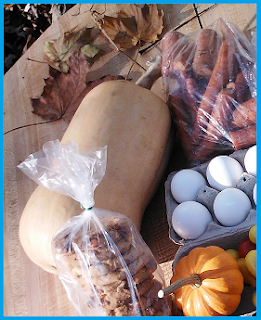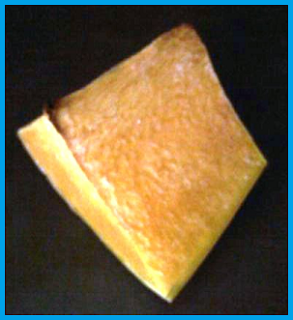Take for instance, my last butternut squash purchase at the farmers market at the end of October.
It was longer than a full carton of eggs, and as you can see, was spectacularly thick. When taking these factors into account, plus the fact that the vendor was only charging a dollar for it, how could I say no?
I mean, the amount of squash puree I could make from this was staggeringly huge!
So, what's the problem, you ask?
Well, my typical means of pureeing a summer squash is simple. I cut it into small chunks, and throw it into my trusty microwave steamer for about 5-7 minutes to soften it for the blender.
Easy.
Not this time, though.
See, the thing was huge. So huge, in fact, that it would have taken me a minimum of 6 rounds in the steamer to finally have the whole thing softened. Probably, it would have taken even longer.
Even if I was ok with that, though, I'd have to deal with the fact that many of the chunks of butternut would be skinless due to the size of the squash, which means that quite a few nutrients would get washed away in the process.
I'd have to use the oven.
I know what you're thinking...
"What's the big deal?"
The big deal was that because I don't use the oven to soften squash prior to making it a puree, I had no idea what temperature it needed to be set at. Nor did I know how long it would take.
I went from one cooking site to the next, and to the next... and the next. The good news was that every one that I went to gave me the same temperature: The standard 350 degrees. This was good.
The problem was the baking time.
Times ranged from 30 minutes to an hour. There didn't appear to be any set pattern to why the baking times changed for each individual writer. No, really. Websites that showed halved squashes being baked ranged from 45-60 minutes, or even more in some cases. Chunked butternut squash was even worse, ranging from 30 minutes to a full hour.
In a nutshell, everyone was giving instructions for their specific squash, rather than giving a general idea of how to adjust times for a given size. Indeed, only one of the seven sites that I went to even mentioned that cooking times may need to be adjusted.
Don't get me wrong, I know advice on how to adjust cooking times is out there... I just didn't see any in my general search, and I only had a small amount of time before I had to start... or risk having to wait for another day in which I'd have enough time to do it.
I hate waiting.
I decided to use what I know about the proper texture and wing it. Sure, I'd spend a lot of time hovering over the oven, but it'd be worth it. With this decision made, I went over to cut up my squash.
I attempted to cut into my enormous butternut squash.
The knife didn't want to cooperate.
I used a bit more force. The knife managed to cut a full centimeter into it, but not more.
I switched knives, and tried again, and again, and...
That squash was rather tough.
This told me that if I had actually removed it from the refrigerator and let it go to room temperature overnight, I probably could've avoided my difficulties. Foods, after all, harden when they get cold.
Basic knowledge.
Oops.
Once I finally had the squash at room temperature, I scooped out the seeds and hacked it into large chunks that were between three and four inches thick each (yeah... not very uniform), and placed them on the biggest cookie sheet I own, skin side down.
Keeping it skin side down helps you avoid unnecessary nutrient loss. The mere act of cooking will cause some of the nutrients to be lost, but not enough to make a difference. Keeping the squash skin side down keeps much of the nutrient rich moisture from draining out onto the pan.
I left a lot of strings, because they don't bother me. I don't feel they harm the overall puree, at all. Many people disagree, however, so whether or not to remove them is an individual choice.
I placed the cookie sheet on the top rack my oven, which was preheated to 350 degrees, and waited.
And waited,
And waited.
The entire process took me about 35 minutes, but I also had to open the oven a few times, since it doesn't have a light, so uninterrupted baking time may have only been about 30 minutes.
Don't use my cooking time as a guideline, though.
Remember what I said about the chaotic differences in cooking time? Squash size, ripeness, and temperature are all factors that will determine how long it'll take you.
So instead, learn to recognize when it's done by appearance and by texture.
Here's what mine looked like. It's a good guide.
The color of the butternut squash will change.
Mine went from a pale yellow to a vibrant gold. The outside looked dry. The edges had just begun to brown.
Since we're softening it for puree, rather than roasting it, we don't need to let it brown any more than this. We just want a hint of it along the corners.
Texture is just as important.
We don't need a squishy mess. Instead, we want the butternut squash to feel like it has a slightly tough outer "skin" that can be easily dented if we poke at it with a fingertip. Dented... not pierced. No need to wait any longer than absolutely necessary!
Of course, this is only Step 1.
Next we'll need to puree the butternut squash. The good news is that's the easy part. I'll discuss it tomorrow. Butternut squash can be pureed immediately after the baking process, or you can keep the baked chunks in a sealed container in the refrigerator and do it at a later time.
Whichever works best for you.







No comments:
Post a Comment